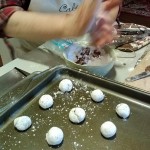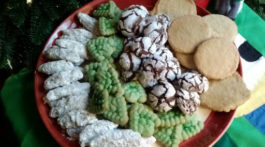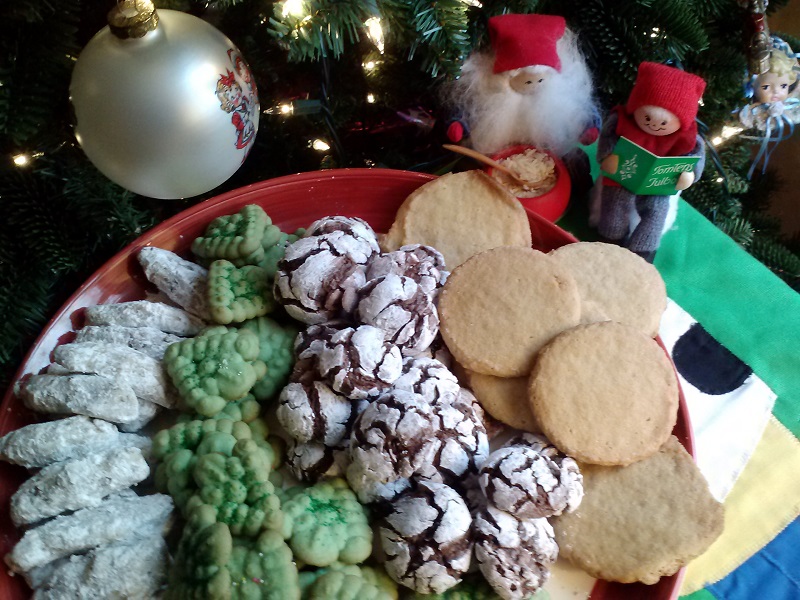Like many people, when I think of Christmas, I think, “Cookies!” and I don’t mean the kind left on your computer after a bout of online shopping. These are the ones piled high on platters, given in tins, left out for Santa, filling the house with seductive aromas as they bake, and connecting the generations in family traditions.
As December progresses, grocery stores sport pyramids of flour and sugar. Shelves are lined with the supplies of the season: cinnamon, cloves, ginger, and vanilla set in rows; chocolate in chips, bars and chunks piled high; bags of dried fruits and every variety of nut crowded in bins. Red and green food coloring as well as sprinkles deck the aisles, and in the dairy department, butter and cream cheese fly from the shelf.
At home, the baking equipment comes out from the dark recesses of cupboards: cookie presses; wooden molds; baking irons and rolling pins. Cookie cutters in the shape of stars, Santas, wreaths, snowmen and trees reappear. The recipe boxes of mothers and grandmothers – dormant most of the year – emerge to be combed through for favorite recipes. Cookies, more than any other food, bring back memories of Christmas past.
Many of our cookie traditions go back hundreds of years to Europe and were already evolving in the Middle Ages as precious sugar and spices became more readily available and affordable. Sweet treats were reserved for special occasions like Christmas, when bakers had the resources to create the ancestors of cookies we enjoy today.
There are some cookie traditions that are found all across Europe. One of the oldest is a spice cookie. Known as Peppernotter in Scandinavia, as Pfeffernüsse in Germany and as Pryiniki in Russia – these are all made with cinnamon, cloves, allspice and almonds. A recipe called Sugar & Spice cookies, adapted from a 1981 issue of Southern Living carries on the ginger cookie tradition in our family. Granddaughter Moira puts them on her list of holiday favorites.
Many cultures also have a ginger cookie: Spekulatius in Germany, Speculaas in Holland, which are made with traditional molds or a special rolling pin, which emboss patterns onto the cookies. In England, ginger “biscuits” made into shapes are popular, and gingerbread men and houses (although begun as a German tradition) abound.
Russian Tea Cakes, Viennese almond crescents, and Mexican polvorones are usually round balls of butter, sugar, vanilla and finely ground nuts, rolled twice in powdered sugar. Pecan Fingers, from this cookie tradition, are a favorite across generations of Marsha’s family, no doubt from their roots in Georgia nut country. Hand-shaped and fussy to make, they are prized by her dad and sisters. The recipe in her mother’s handwriting says, “bake at 275° – it takes a while.”
Shortbread, plain, shaped with a cookie cutter, decorated or coupled with jam, although most associated with Scotland, is found worldwide.
Flat cookies made in a special two-sided iron griddle, similar to a waffle iron, vary from country to country – in Italy Pizzelles and in Sweden Krumkake. There are also cookies filled with raisins, nuts and dried colored fruits, cookies rolled with sugar and cinnamon, as well as sugar cookies that can be decorated and transformed into works of art to round out the platter.
In the US, we have cherry-picked our favorites from this bounty and adapted them to local tastes and ingredients. Each family has its own repertoire of favorites passed down the generations from mothers and grandmothers to small children “helping” while standing on a stool in an oversized apron.
Cousin Joyce makes her popular Toffee Almond Sandies from a family recipe that goes back to her roots in Mt. Pleasant, Iowa. Her hand-written recipe book automatically falls open to the well-used Sandies page, which is covered with spatters and stains from years of baking, noted with the reminder to “use a big bowl.”
My wife Marsha makes Christmas Tree shaped cookies using a cookie press – a device a little like a caulking gun that squeezes the dough through a tree-shaped template. It’s a tricky business, but she has mastered the technique – getting the sugar cookie dough just the right consistency and coloring it a cheerful holiday green. The cookies disappear quickly, and even granddaughter Moira, with her four years of cookie eating experience, says “Grandma’s Christmas Trees – mmm delicious”.
Interestingly, chocolate doesn’t seem to fi gure quite as prominently in the Christmas cookie category, although I always looked forward to my mother’s Chocolate Crinkles, little fudgy balls rolled in powdered sugar that cracked as they baked. Moira’s dad, Cameron, and I both like chocolate, so we request the year-round favorite chocolate chip cookies, which can be customized for the holiday season with the addition of a handful of dried cranberries or red and green M&Ms.
gure quite as prominently in the Christmas cookie category, although I always looked forward to my mother’s Chocolate Crinkles, little fudgy balls rolled in powdered sugar that cracked as they baked. Moira’s dad, Cameron, and I both like chocolate, so we request the year-round favorite chocolate chip cookies, which can be customized for the holiday season with the addition of a handful of dried cranberries or red and green M&Ms.
Oatmeal cookies, prized year round, are on the Christmas cookie platter, too, as well as Grandma’s Maritz’s sugar cookies (irresistible to me), which are perfect for holiday decorating, cutting into shapes, or passing through the cookie press. Fudge, although not strictly a cookie, appears on our holiday sweets platter. The fudge has to be rationed against my complete lack of self control.
As you celebrate on December 25th, I hope your platters are full of your own family traditions. Merry Christmas to all, and may your day be sweet!
Send me some of your favorite cookies at notbreadalonefw@gmail.com.











No Comment